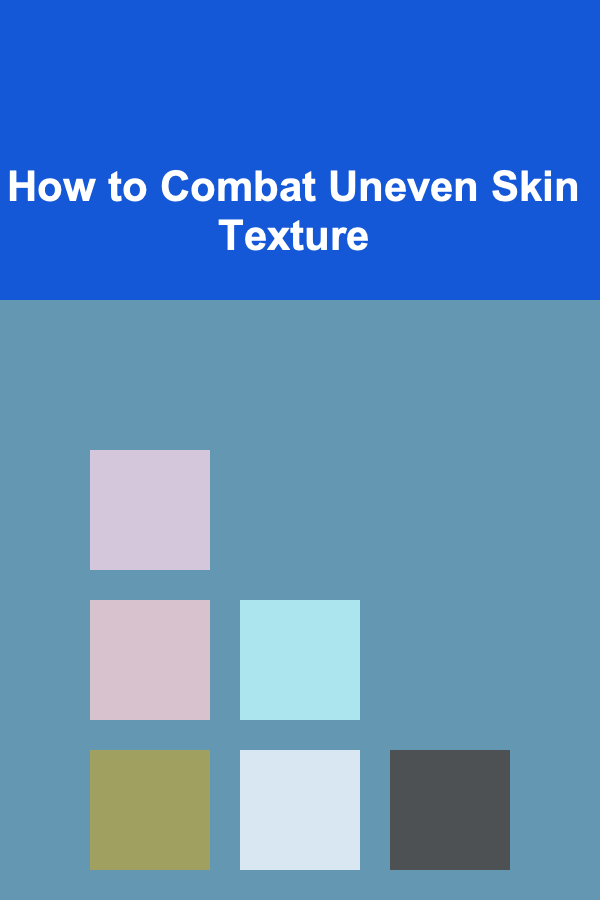
How to Combat Uneven Skin Texture
ebook include PDF & Audio bundle (Micro Guide)
$12.99$7.99
Limited Time Offer! Order within the next:

Uneven skin texture can be a frustrating concern for many people, affecting self-esteem and overall skin health. Whether it's caused by acne scars, enlarged pores, dryness, or other skin issues, the desire for smoother, more radiant skin is common. This article will explore the causes of uneven skin texture and provide comprehensive solutions to combat it.
What Causes Uneven Skin Texture?
Uneven skin texture occurs when the surface of your skin is rough, bumpy, or irregular. Several factors can contribute to the development of uneven texture, including genetics, lifestyle, and environmental factors. Understanding the root causes of uneven skin texture is essential for effectively addressing and managing the issue.
1. Acne and Acne Scarring
Acne is one of the most common causes of uneven skin texture. Pimples, cysts, and blackheads can damage the skin's surface, leading to scars and unevenness. When acne lesions heal, they often leave behind marks, including hyperpigmentation (dark spots) and textural changes (scars). Over time, these scars can cause the skin to look bumpy and uneven.
2. Sun Damage
Excessive sun exposure can cause a range of skin issues, including uneven texture. UV rays damage the skin by breaking down collagen and elastin fibers, leading to sagging, roughness, and fine lines. Sun damage can also lead to hyperpigmentation and the formation of age spots, which contribute to an uneven skin surface.
3. Dry Skin
Dryness is another factor that can cause skin texture problems. When your skin lacks moisture, it becomes rough and flaky. This can make your skin look dull and uneven. Without proper hydration, dead skin cells can accumulate on the surface, further exacerbating the appearance of uneven texture.
4. Enlarged Pores
Enlarged pores are a common skin concern that contributes to uneven skin texture. Excess oil production, clogged pores, or loss of skin elasticity can cause pores to become larger. This often results in a bumpy skin surface and an uneven appearance. While enlarged pores are natural, taking steps to minimize their visibility can help improve overall skin texture.
5. Aging and Collagen Loss
As we age, our skin naturally loses collagen and elastin, which are responsible for maintaining its structure and elasticity. The reduction of these proteins can lead to sagging, fine lines, and an overall uneven texture. This process is accelerated by environmental stressors, such as pollution and UV rays.
Steps to Combat Uneven Skin Texture
Now that we understand the causes of uneven skin texture, let's explore how to address and improve it. The key to smoother skin lies in a consistent skincare routine, the right products, and lifestyle changes. Here are some effective strategies to combat uneven skin texture.
1. Exfoliation: The Foundation of Smooth Skin
Exfoliation is essential for combating uneven skin texture. It helps to remove dead skin cells from the surface, revealing fresh, smooth skin underneath. There are two main types of exfoliation: physical exfoliation and chemical exfoliation.
a. Physical Exfoliation
Physical exfoliation involves using a scrub or tool to manually slough off dead skin cells. This type of exfoliation can be effective but should be done gently to avoid irritation. Look for scrubs with fine, smooth particles that will not scratch the skin or cause microtears.
b. Chemical Exfoliation
Chemical exfoliants use acids to dissolve dead skin cells and promote cell turnover. Alpha hydroxy acids (AHAs) and beta hydroxy acids (BHAs) are the most common types of chemical exfoliants:
- AHAs, such as glycolic acid and lactic acid, are water-soluble and work on the skin's surface to exfoliate. They are ideal for dry or sun-damaged skin.
- BHAs, such as salicylic acid, are oil-soluble and penetrate deeper into the pores. They are best for acne-prone skin, as they help to clear clogged pores.
Using a chemical exfoliant 2-3 times a week can significantly improve skin texture by encouraging faster cell turnover and revealing smoother skin.
2. Hydration: The Key to Smooth, Plump Skin
Hydrated skin is smoother and healthier. When your skin is properly moisturized, it looks more plump, radiant, and even. Dehydrated skin often appears rough, flaky, and dull, exacerbating textural irregularities.
a. Moisturize Daily
To keep your skin hydrated, use a good moisturizer that suits your skin type. If you have oily skin, opt for an oil-free, lightweight gel moisturizer. If you have dry skin, look for thicker creams or oils that provide intense moisture.
b. Use Hydrating Ingredients
Look for ingredients like hyaluronic acid, glycerin, and ceramides in your skincare products. Hyaluronic acid is particularly beneficial because it attracts moisture to the skin, plumping it and smoothing texture. Ceramides help to repair the skin's barrier and prevent water loss, while glycerin draws moisture into the skin.
c. Avoid Hot Showers and Harsh Soaps
Hot water can strip the skin of its natural oils, leading to dryness and texture issues. Similarly, harsh soaps can disrupt the skin's barrier, making it more prone to irritation and dryness. Stick to lukewarm water and gentle, hydrating cleansers.
3. Target Acne and Acne Scarring
If acne is a cause of your uneven skin texture, treating it effectively is essential. Here are some tips for managing acne and minimizing scarring:
a. Use Acne Treatments
Topical treatments containing benzoyl peroxide or salicylic acid can help to reduce acne flare-ups. For more severe acne, you may need prescription treatments like retinoids or oral medications.
b. Treat Scars with Targeted Products
Once acne has healed, treat the scars with products that promote skin regeneration. Look for serums or creams containing ingredients like:
- Retinoids: Retinoids increase cell turnover and can help to fade acne scars over time.
- Vitamin C: This antioxidant brightens dark spots and helps to even out skin tone.
- Niacinamide: Niacinamide reduces inflammation, brightens the skin, and minimizes the appearance of pores.
c. Consider Professional Treatments
For stubborn scars, consider professional treatments like chemical peels, microdermabrasion, or microneedling. These procedures help to resurface the skin and reduce the appearance of scars.
4. Sun Protection: Preventing Further Damage
Sun damage is a significant contributor to uneven skin texture. The sun's UV rays break down collagen, leading to sagging, wrinkles, and rough skin. Protecting your skin from the sun is essential to maintaining smooth, even skin.
a. Wear Sunscreen Daily
Make it a habit to apply sunscreen with at least SPF 30 every morning, even on cloudy days. Look for a broad-spectrum sunscreen that protects against both UVA and UVB rays. Choose a formula that suits your skin type, whether it's oil-free for oily skin or hydrating for dry skin.
b. Reapply Sunscreen Throughout the Day
Reapplying sunscreen every two hours is crucial, especially if you're spending time outdoors. Consider using a setting spray or powder sunscreen for easy reapplication throughout the day.
5. Consider Professional Skincare Treatments
For more significant skin texture issues, you may want to consider professional treatments that can accelerate skin renewal. These treatments are often more effective at addressing severe concerns like acne scars, sun damage, and deep wrinkles.
a. Microneedling
Microneedling is a procedure that involves tiny needles puncturing the skin to stimulate collagen production. This treatment can improve skin texture, reduce the appearance of scars, and give your skin a smoother, more even surface.
b. Chemical Peels
Chemical peels involve applying a chemical solution to the skin to exfoliate the top layers and reveal fresh skin. This treatment is particularly effective for addressing sun damage, acne scars, and uneven texture.
c. Laser Treatments
Laser treatments, such as fractional CO2 laser or erbium laser, can help to resurface the skin, reduce scars, and improve overall texture. These treatments are often more aggressive and may require downtime for healing.
Lifestyle Changes for Healthier Skin
In addition to skincare routines and professional treatments, certain lifestyle changes can help improve skin texture. These changes promote overall skin health and can support smoother, more even skin.
1. Eat a Balanced Diet
What you eat can significantly impact your skin's health. A diet rich in antioxidants, healthy fats, and vitamins supports collagen production and helps keep the skin firm and smooth. Include foods such as:
- Vitamin C-rich foods: Citrus fruits, strawberries, bell peppers.
- Omega-3 fatty acids: Fatty fish, walnuts, chia seeds.
- Zinc-rich foods: Beans, nuts, whole grains.
2. Stay Hydrated
Drinking enough water is essential for maintaining healthy, hydrated skin. Aim for at least 8 glasses of water a day to help keep your skin moisturized from within.
3. Get Enough Sleep
Adequate sleep is essential for skin repair and rejuvenation. Aim for 7-9 hours of quality sleep each night to allow your skin to regenerate and maintain its smooth texture.
4. Manage Stress
Chronic stress can lead to skin issues like acne and eczema, which contribute to uneven texture. Practice stress management techniques such as yoga, meditation, or deep breathing exercises to support your skin's health.
Conclusion
Uneven skin texture is a common concern that can be addressed with a combination of consistent skincare practices, professional treatments, and healthy lifestyle choices. Whether your skin texture issues stem from acne, sun damage, dryness, or aging, there are effective solutions available to restore smoothness and radiance. By understanding the causes and implementing the right strategies, you can achieve a more even, youthful-looking complexion.

How to Clean Your Home Using Natural and Eco-Friendly Products
Read More
How to Create a Screen-Free Zone with Organized Activities
Read More
How to Ensure Proper Drainage Around Your Home's Foundation
Read More
How to Organize Your Music Collection for Easy Listening
Read More
How to Utilize the Schwab PCRA for Personalized Investment Strategies
Read More
Understanding Privacy by Design: A Comprehensive Guide
Read MoreOther Products

How to Clean Your Home Using Natural and Eco-Friendly Products
Read More
How to Create a Screen-Free Zone with Organized Activities
Read More
How to Ensure Proper Drainage Around Your Home's Foundation
Read More
How to Organize Your Music Collection for Easy Listening
Read More
How to Utilize the Schwab PCRA for Personalized Investment Strategies
Read More